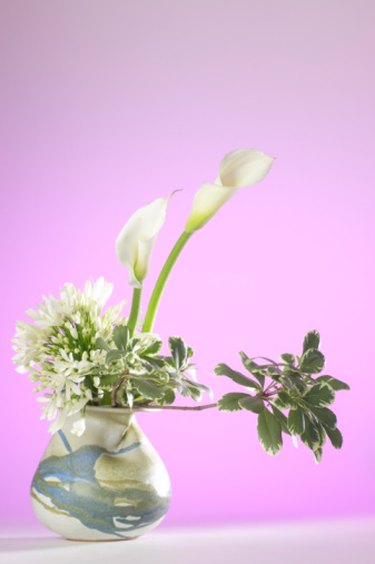
Anytime flowers and foliage are placed in a container, the result is considered a floral arrangement. But for special occasions or if you want to express your artistic nature, a more structured flower arrangement may be needed. Traditional western floral design dictated that the composition be symmetrical, or balanced. In the mid-20th century, the asymmetrical style of flower arrangement became more widely acceptable, influenced in part by the Japanese ikebana style. Deciding to create your floral arrangement using an asymmetrical style can result in a dynamic and interesting flower display.
Ikebana
Video of the Day
The Japanese art of flower arranging is called ikebana, an expression of spiritual harmony between humans, earth and heaven. There are several ikebana disciplines, each slightly different, but the overall general concept is that each element is symbolic, with great care in placement and open space within the floral design. Asymmetry is an essential element in any ikebana flower arrangement, reflecting the strength and weakness, light and darkness of nature.
Video of the Day
Crescent
As the name implies, a crescent-designed flower arrangement will be in a new moon crescent or "C" configuration. Crescent arrangements are one of the easiest asymmetrical floral designs to construct. Place larger focal blooms toward the base, or bottom, of the design curve to give balance and depth to the arrangement, with airy and lightly curved flower stems and branches curving up and outward. Crescent-shaped flower arrangements are appealing to the eye, giving the viewer a sense of calm.
Hogarth "S" Curve
The Hogarth "S" curve floral arrangement, named after creator William Hogarth, expands the idea of a crescent design. Start with long flowering stems that have a gentle curve to create a visual S-shaped movement, either vertically or horizontally. Fill in the S with the focal flowers close to the base, the add filler flowers moving along the original S curve stems. S-curved floral arrangements are striking, grabbing the attention and should be placed where the arrangement becomes the main focal point. The S curve can also be used in floral wreath designs.
Asymmetrical "L" or Triangle
Using the concept of the traditional balanced triangular floral arrangement structure, the asymmetrical "L" triangle design creates a one-sided, or lopsided, appearance. The arrangement will have floral height with more flower stems protruding from one side but not the other, to resemble an off-center triangle form. Asymmetrical flower arrangements generally utilize fewer flowers in the design, with a more open look.